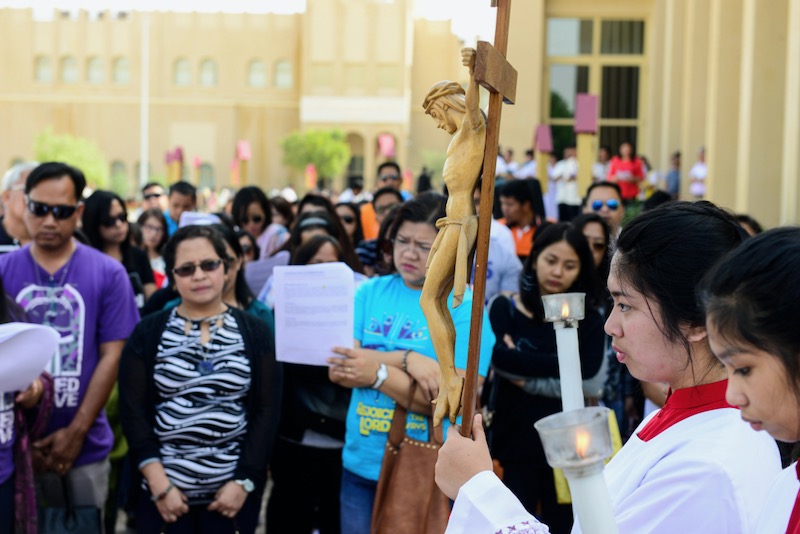You can get an Advent calendar filled with almost anything these days, it seems. Unfortunately for my children, I’m a purist on Advent calendars, and I buy only the traditional (often German) ones with 24 little doors to open and 24 little holy pictures behind them. I particularly like the ones that have Bible quotes on the inside of the doors. It’s harder to find this sort of Advent calendar in the shops these days, but on-line it’s OK.
This is the original type of Advent calendar, simply a way to count down the time until Christmas arrives, like crossing off the days before a holiday or a big treat, or counting down in “sleeps”, which I still do very occasionally. One small hitch is that Advent rarely starts on 1 December so you can find yourself dealing with a smartie-breeks child who wants to know why they can’t open any doors until next week if it’s already Advent in church. This is what you might call a “teachable moment”. We’ve done quite well recently, with Advent and December coinciding in 2013 and 2019, with a near miss in 2014, and it works again next year (2024), but then not for a little while.
We had a beloved (for the children, great-)aunt who was a “friend” of numerous museums and big art galleries in London, and once she had spotted the children’s Advent calendars, she used to go and buy beautiful Old Master Advent calendars each year, I think in the January sales. Her list of recipients grew every year as she extended it to children of in-laws and friends. Sadly, she is no longer with us, but every year we remember her especially at the time when we give out the calendars (one child even calls them “Aunty Dorothy calendars”). It’s a nice way to be remembered, and a lovely thing to be remembered for.
Advent calendars became more of a retail opportunity when opening the door and finding a new picture was deemed insufficiently thrilling, and other things were put behind the doors. The question is what to put behind the doors that actually enhances the idea of Advent. I can see the point of a set of doors or drawers with a crib figure or similar to build up a whole Nativity scene. One year both Lego and Playmobil produced Advent calendars like this, too pricey for us, but we knew one family who actually bought both, and our children were green with envy. I hope it was possible to put the bits away for use in other years, but I suspect they were more likely to become part of the usual family toy silt.
The different little holy pictures work the same way: it’s like a stage where a spotlight comes on to a different person or group each day to build up the whole scene. My mother made a cloth Advent calendar for us which causes me problems every year, as it only has small pockets (our crib figures are too big and awkwardly-shaped) and nothing except some sort of sweetie really fits. I did try really hard one year, hunting out twentyfour interesting little different things, only to find the bigger children moving the pocket contents around when they thought they could get away with it, to select their favourite for their own next turn to be the opener.
Mostly what is available in shop Advent calendars is small pieces of chocolate, but I was very unimpressed to find that all the chocolates are the same design (and usually the picture on the front is fairly boring too, just a Father Christmas). The chocolate ones are a great seller, though, if you are running a Christmas Bazaar overseas, and I speak from experience here. With the ones that just have pictures, I like door 24 to be bigger than the others. I remember it used to be a double door in the Advent calendars we had when I was little. Surely it’s boring if every door just has the exact same thing? Where is the sense of progression? And it’s probably down to those still-rankling feelings of unfairness about that door being the best one, which means I always get our children a calendar each, after sharing one every year as a child and never being the one to open that special door… Maybe all the doors being the same is a help for larger families.
More seriously, a few years back, Advent calendars started getting too far away from their roots. Nowadays it is possible to spend enormous amounts of money on them. They may contain food delicacies, assorted booze, cosmetics, jewellery, bath bombs and similar, usually with the emphasis on treating yourself or some sort of indulgence, but worst of all, some of them don’t even have the right number of doors or boxes. Our youngest daughter (Margaret) came across an advertisement for one with fifteen (or it may have been eighteen) doors, which we found baffling. When would you start opening it? Do you count back from Christmas or forward from 1 December?
I’m all for Advent not being penitential; it’s very different from Lent, but it is an exercise in mindful waiting, prayerful patience, even a way to learn about delayed gratification, not a way to anticipate Christmas and risk turning it into an anticlimax. Advent should take you up to Christmas and deliver you on the day with heightened anticipation, not already having to throw away wrappings and feel that the surprises have finished. Watching and waiting and feeling the excitement grow is what Advent is about, just like a pregnancy, even though it’s only four weeks long.
Another (and simpler) version of enhanced counting is the Advent wreath, which counts down by lighting one more candle every Sunday until all four are lit (and some wreaths have an extra central candle for Christmas Day). Single Advent candles have lines on them so you can use them like Roman clock candles, but we did not have a happy experience with one of these.
It was the beginning of Advent, and I was making a real effort to involve the children in Advent as a holy run-up to the big day. I thought we would all sit around the table before tea, light our Advent candle for the time to burn down one measure, and maybe say a prayer, or sing a carol. But as soon as I turned the lights off to light a candle, the second smallest dived under the table shrieking, “No bangs! No bangs!” and the littlest started howling from the high chair. Firework night had obviously been far too traumatic, and we don’t really do fireworks any more (or Advent candles either).
I enjoy Advent, because looking forward to something is always fun and it means that I have a solid excuse for focusing on the Christmas stockings. Spoiler alert: small children (and mine) should stop reading now. I do shop for the stockings all year round, because I need enough stuff to fill six of them (plus extra if we have visitors), and it takes a while; but once we are in Advent, I feel licensed to concentrate on it. There are certain items which have to be there for historical reasons (an apple and a tangerine, but I decided to give up on the balloon after years of trying to ram one into the top and having it pop out at an inconvenient moment). There have to be the same number of things in each stocking in case anyone checks. Edibles and toiletries are fine, but quirky and personal is even better and my target is to have the children take all the stocking contents away with them rather than leaving them behind for me to have to deal with in the rundown after Christmas.
Maybe doing the stockings is fun because all the presents have to be smallish and cheap; I get many of them from charity shops (not the edibles and toiletries), and I really do pick little things up all year: a packet of seeds, a kitchen gadget, an iron-on patch. If I had unlimited funds, it wouldn’t be as enjoyable, and I’d never be able to fit everything into the stockings (it can be difficult now, but luckily both Margaret and John (middle son) are January birthdays, so I have an off-ramp).
Knowing the recipient is crucial. I’ve done stockings for visitors, and it’s much harder when you can’t share a joke or find something specially chosen for that person’s particular interests. Obviously when it’s your children, you have reams of past events and memories to draw on, with special family associations, and you know who gets the dinosaur face flannel and who the clockwork robot. It’s the sort of thing that even the children don’t argue about. I should say that this sending-up approach to presents is entirely reciprocated by my children. Last year I was given a small furry teapot, a truly bizarre object, which I love, both for the giver, and because teapots are one of my totems. It’s wedged into the bars of my bed and occasionally leaps out and falls on my head. It always makes me smile.
The Advent calendars have all been handed out or posted; now we can concentrate on waiting. Christmas is the time for indulgent presents and feasting, but it needs to be a communal feast, a time to share treats and enjoy doing things together. Christmas is when the counting is over; all the doors have been opened. But Advent is a special time all of its own, and worth marking.
Kate Keefe composes musical settings for the Mass and writes about the psalms. You can follow her on Facebook, Twitter and LinkedIn .



 Loading ...
Loading ...
What do you think?
You can post as a subscriber user ...
User comments (0)